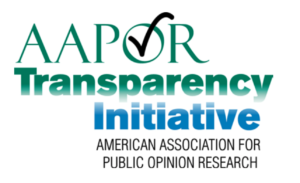transparency initiative
We’re an open book.
 MyVoice is a proud member of the American Association for Public Opinion Research (AAPOR) Transparency Initiative (TI) and joined the organization in January 2021. The goal of the Transparency Initiative is to promote methodological disclosure and transparency in research design by supporting survey organizations in creating and utilizing simple and efficient means for disclosing methodology when publicly disseminating results.
MyVoice is a proud member of the American Association for Public Opinion Research (AAPOR) Transparency Initiative (TI) and joined the organization in January 2021. The goal of the Transparency Initiative is to promote methodological disclosure and transparency in research design by supporting survey organizations in creating and utilizing simple and efficient means for disclosing methodology when publicly disseminating results.
By joining the TI, MyVoice has pledged our commitment to practicing transparency in reporting our survey findings and maintaining openness about our research methodologies so that you—fellow researchers, our thousands of MyVoice participants, and the public—can question, scrutinize, learn, and improve on the work we do and the way we work. With this commitment we hope to support readers in understanding our work and to appropriately represent and honor our survey participants.
AAPOR Transparency Initiative Disclosures
To ensure continued transparency of our survey methods we have detailed our study procedures and required TI disclosure items below. In addition to providing this as a resource to individuals reviewing our published results, we ask that collaborators include or cite this information in all of their published work. In these disclosures, we would also like to acknowledge the unmeasured error associated with all forms of public opinion research.
Thank you for helping us to create a world of science that practices openness and transparency.
Transparency FAQ
Who sponsored the research and who conducted it?
The MyVoice team completes their own survey data collection from MyVoice participants. Question development, data analysis, and manuscript preparation are completed both by members of the MyVoice team as well as external collaborators who contract with MyVoice for data collection.
What is the population under study and its geographic location?
During enrollment, participants must also complete an additional opt in verifying their previously provided date of birth to be eligible to receive and respond to the weekly surveys.
What procedures are employed to screen and recruit research subjects?
While MyVoice recruits based on national benchmarks, it is not a nationally representative sample and recruitment via social media may also create bias limiting the generalizability of the findings. However, most youth today use social media and recruiting via these platforms may help increase representation of youth who are not traditionally engaged in research.
How are participants compensated or incentivized to participate?
Newly enrolled participants also earn an additional $5 at the completion of their first 12-weeks of participation for completing their baseline demographic survey.
What instrumentation (e.g., questionnaires, discussion guides) is used to collect survey data? What data collection strategies are employed and in what language? What dates are data collected?
MyVoice iteratively develops questions with a team of physicians, qualitative researchers, mixed-methods experts, and youth to create appropriate and clear questions on a variety of topics. Each topic includes 3-5 survey questions and specific question language, as well as the date they were posed, can be located in our online question bank.
MyVoice questions are posed each week, in English, via text message. Prior to June 2023, MyVoice used a platform called Textizen by Granicus LLC but has since switched to a Twilo integration in REDCap. Youth responses are then downloaded as CSV files and deidentified prior to data review.
How many research subjects are included by data collection strategy?
While the number of MyVoice participants fluctuates, the MyVoice cohort typically ranges from 1,000 to 1,200 participants. All participants are included using the same text message data collection strategy. The exact number of participants sent a specific set of questions as well as the number of respondents to the set will vary each week. Please refer to topic specific dissemination efforts for additional details on cohort size and response rates.
What methods of interviewer and/or coder training, supervision, and monitoring are used, if external interviewers or coders are used? How are the data processed? What procedures are used to ensure data quality?
Data collected and analyzed by the core MyVoice team is reviewed and coded by study investigators and external coders are not used. Data is not weighted in analysis unless otherwise specified and results presented reflect cohort frequency. Data cleaning is conducted by the MyVoice team to ensure responses and questions align and nonsensical responses may additionally be categorized as “junk” during the coding process and excluded from further analysis. Collaborators with MyVoice may use different practices and will specify these details if applicable in their dissemination.
